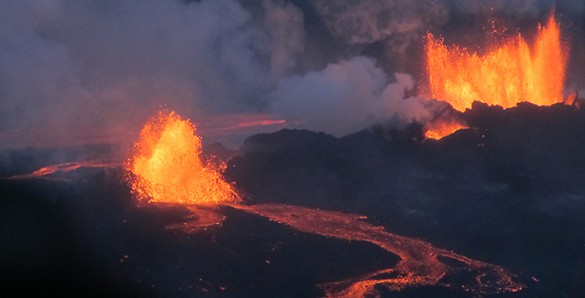
For the last eight years I have been traveling to Iceland with students to study the products of its hyperactive volcanism, but it was only last month that I had the great good fortune to witness an actual eruption close up. Although eruptions have occurred during our time investigating Iceland, most notably the Eyjafjallajökull event that shut down much of the World’s air traffic for a time in 2010, none of us had actually seen one in action. This time, I happened to be in just the right place at the right time.
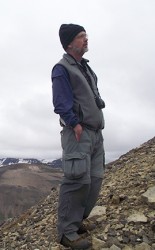
My wife, Molly Miller – also a professor in earth and environmental sciences – and I were traveling in Iceland and Greenland, mostly for fun, in late August and early September. Earthquakes had suggested that something important was happening in central and northern Iceland in the last half of August, and on Aug. 30, the day we left for Greenland and lost contact with the outside world, we learned that an eruption had just begun at an isolated location called Holuhraun. Upon our return to civilization – Iceland – on Sept. 6, we learned that a powerful eruption was underway.
I had previously planned for us to visit Mývatn, a strange and beautiful place in northern Iceland where lush green pastures and dwarf forests are juxtaposed against a dramatic, barren landscape shaped by active volcanoes, glaciers, and enormous eruption-induced floods of glacial melt water. Mývatn, by coincidence, was the closest “population center” to the eruption, which was taking place about 50 miles to the south. (In Iceland, population center means any place with more than 100 people or so.) A vast area around Holuhraun had been evacuated, reaching almost to Mývatn, primarily in response to concern about the potential for catastrophic flooding from melting glacial ice.
The evacuated area is very important to the economy of northern Iceland because this spectacular landscape provides opportunities for adventure/ecotourism, opportunities that the resourceful Icelanders make the most of. But the eruption-induced closure removed this major source of income for the lucrative final part of the tourist season.
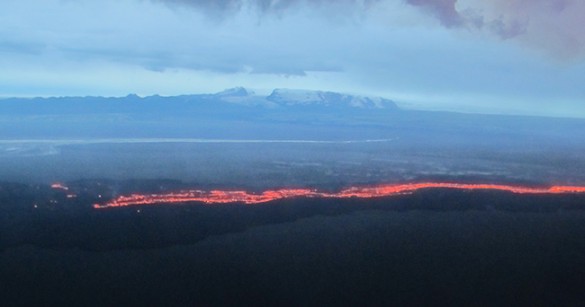
When we arrived in Mývatn on the afternoon of Sept. 7 we saw flyers posted around town showing that the Icelanders had identified a way to at least partly make up for lost income by offering flights over the eruption zone out of the tiny local airport. We immediately booked the last seat on the last flight of the day. Molly, recognized that witnessing eruptions was closer to my soul and professional interest than to hers – investigating sediment and the fossil traces of animal activity that it contains – and graciously suggested that I take the seat. (She also acknowledges her sense of self-preservation was involved: Although she has made innumerable flights in small planes and helicopters in Antarctica, where she carries out her research, she wasn’t as enthusiastic as I was about heading off into the stormy dusk in a little single-engine plane to fly over an active eruption.)
The flight turned out to be magnificent: close-up views from a variety of angles of enormous, pulsing “fire fountains” – pressurized lava bursting upward as much as 600 feet into the air from four separate vents – large, actively flowing lava streams, and plumes of steam where the molten lava flowed into icy rivers. Ending up on the final flight of the day in gathering darkness was a stroke of luck, providing views of the glowing lava that were enhanced by the subdued lighting. I had seen several eruptions before – small explosive eruptions in Ecuador and at Stromboli, Italy; extrusion of a spire of solidified lava at Mount St. Helens; a lovely little stream of lava in Hawaii – but never anything nearly so exciting or beautiful as the eruption at Holuhraun.
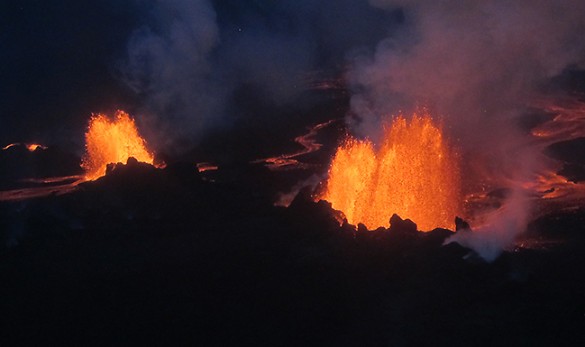
So far, the Holuhraun eruption has been remarkably and fortuitously benign, considering how large it is (Iceland’s largest since 1875 – see below) and how it could have played out. The only immediate threat is poisonous gases, mostly sulfur dioxide with some carbon monoxide. These weren’t evident back on Sept. 7, but they are sufficiently abundant now that scientists and officials who venture near the eruption site now must take serious precautions, and the gas plume is worrisome for whichever parts of Iceland – and potentially mainland Europe – are downwind at any given time. But there are no reported ill effects yet.
What COULD have happened, and might still happen, is much more daunting. The seismicity (innumerable earthquakes ranging from small to quite large) that preceded and has accompanied the eruption has documented the movement of a very large amount of magma from the deep crust. At first, it ascended beneath the huge volcano Bárðarbunga, which lies beneath the vast Vatnajökull ice cap. Eruption appeared to be imminent there, and the ice above Bárðarbunga’s summit caldera has steadily sunk, about 100 feet so far, but there has been no eruption yet. If there were, it would be extremely explosive as lava, ice and water would interact on a grand scale.
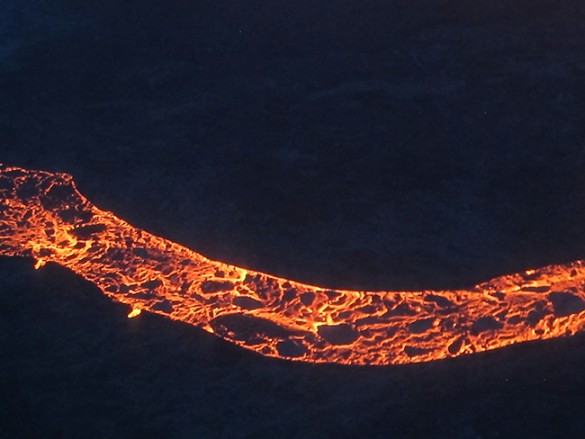
Seismic activity in August showed that much of the magma was escaping along fractures to the north, leading away from explosion-inducing ice –toward the beautiful lake-filled caldera of Askja, which in 1875 was the site of Iceland’s largest eruption in several centuries. That eruption yielded both a lot of lava and an extremely explosive eruption plume. The plume and accompanying gases destroyed agriculture for years in eastern Iceland and led to an Icelandic diaspora, with about 20 percent of the population emigrating, mostly to Manitoba and the Upper Midwest.
So far, the errant magma hasn’t burst forth in either Bárðarbunga’s or Askja’s caldera, either of which could produce a devastatingly explosive eruption. Furthermore, melting of ice in Bárðarbunga’s caldera would likely produce a gigantic jökulhlaup, a sudden flood of massive proportions. But so far, so good: the magma seems to have chosen the one place where it could emerge to create a gorgeous and mostly benign eruption.
Calvin Miller is the William R. Kenan Jr. Professor of Earth and Environmental Sciences